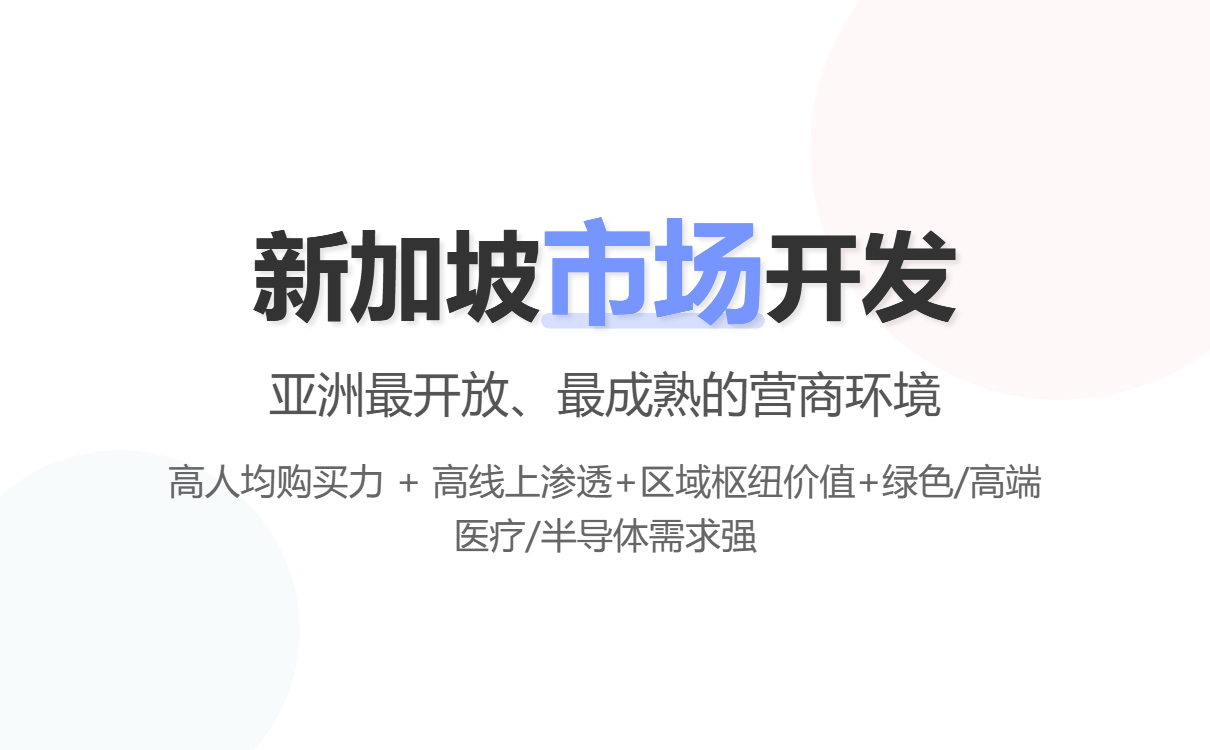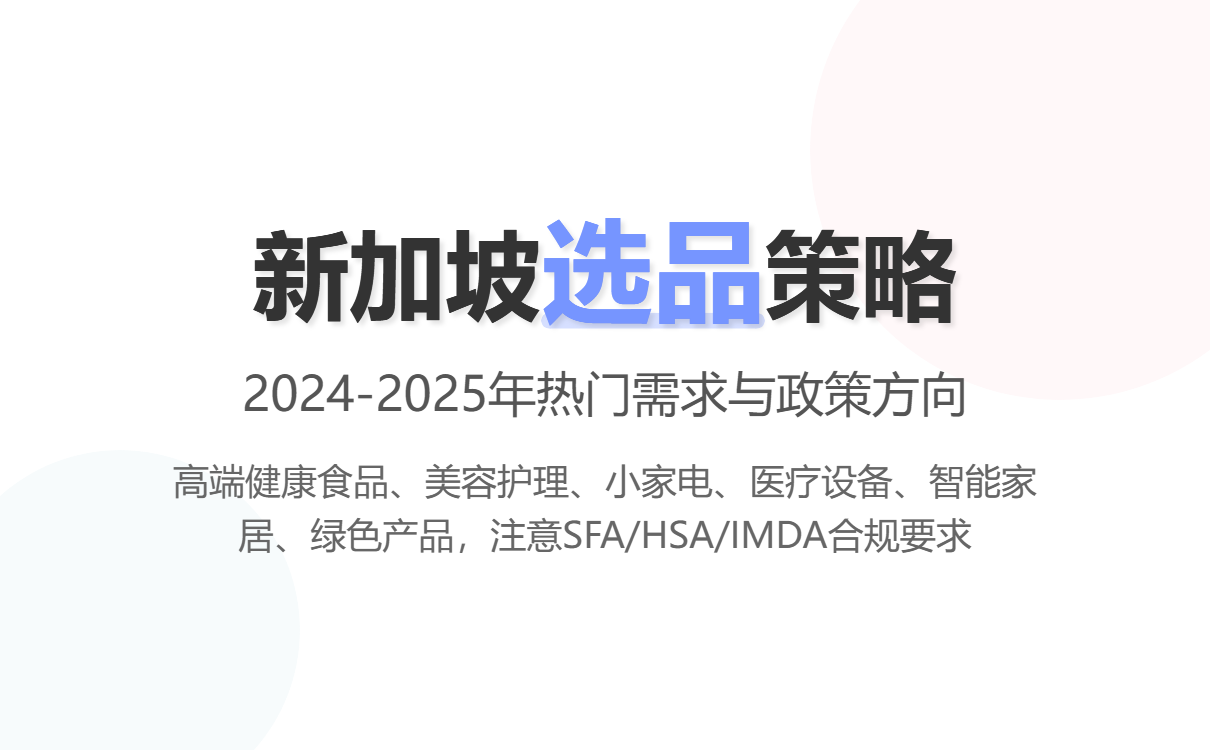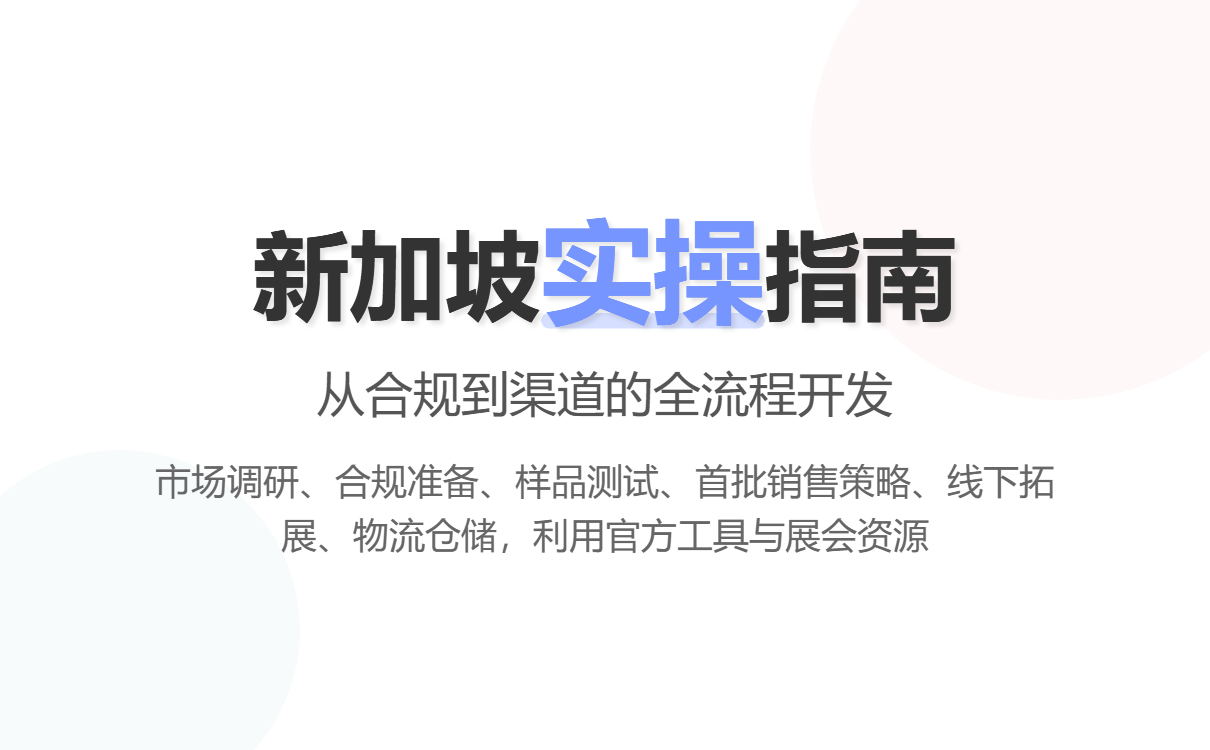
Singapore is one of Asia's most open city-states, boasting a mature legal system and business environment. Despite its small population, it boasts high purchasing power, a transparent market, and convenient logistics and financial services. It serves as a springboard for entering Southeast Asia and establishing a regional headquarters and distribution network. As a foreign trader starting from scratch, you need to master regulatory compliance (certificates/licenses/import bans), pricing inclusive of GST (GST), finding the right channels (local distribution/e-commerce/exhibitions/sourcing platforms), building trust (sampling/quality inspection/after-sales service), and developing responsive local logistics and warehousing solutions.
Country name : Republic of Singapore.
Area : approximately 728 square kilometers (city-state).
Population : By mid-2025, Singapore's total population was approximately 6.1 million (including a large number of expatriates).
Religious composition : Multiple religions coexist (Buddhism, Christianity, Islam, Hinduism, etc.). (See official demographic and social data for details)
Official languages : English (administrative/business mainstream), Chinese (Mandarin), Malay, Tamil.
Capital : Singapore (city-state - both a country and a city).
Economic Overview :
A high-income economy with per capita GDP ranking among the highest in the world; GDP growth will be steady in 2024, with an annual growth of approximately 4%+ in 2024.
Industrial structure : The service industry accounts for a large proportion (finance, shipping, trade, logistics, information and communication services), the manufacturing industry is mainly based on high-end electronics, life sciences, and precision engineering; agriculture accounts for a very small proportion.
Resources : Natural resources are scarce and the country relies on imported raw materials and re-exports; however, it has a world-class port (with strong port and transit trade capabilities) and an international financial center.
Industrial : Semiconductors/electronics, petrochemicals (refining and reprocessing), biomedicine, precision engineering.
Agriculture and animal husbandry : Very small-scale, local agricultural production mainly relies on high-tech greenhouse/urban agriculture, and there is a high dependence on imports.
Service industry : Financial services, shipping and transshipment logistics, business services, information and communications, tourism and exhibitions are the main driving factors.
Tourism : In 2024, there will be approximately 16.5 million international tourists, with tourism revenue reaching a record high (nearly S$29.8 billion in 2024). Continued recovery is expected in 2025.
Foreign trade : Foreign trade accounts for a very high proportion of GDP. In 2024, the main trading partners include China, Malaysia, the United States, etc.; trade with China ranks among the top (in 2024, the goods and services exchanges with China are huge).
Foreign capital/investment environment : Long-term attraction of foreign investment (friendly policies, good tax and business environment), the government provides investment/market expansion support and subsidies through EDB/EnterpriseSG.
Favorable policies towards China :
The China-Singapore Free Trade Agreement (CSFTA) has led to frequent bilateral cooperation and deepening cooperation in bilateral investment and service trade, which is conducive to Chinese products/enterprises taking advantage of the agreement to carry out regional trade and service cooperation.
China-Singapore bilateral trade (key points) : China has long been Singapore's first/second largest trading partner, with large-scale bilateral goods and services, and a free trade framework and investment facilitation arrangements.
Public holidays (officially announced each year) :
Common holiday dates include: New Year's Day, Chinese New Year (2 days), Hari Raya Puasa, Good Friday, Labor Day, Vesak, Eid al-Adha, National Day (August 9), Deepavali, Christmas, etc. The specific dates are announced annually by the Singapore Ministry of Manpower (MOM). For foreign trade, please include these dates in your annual visit/shipment/payment calendar to avoid scheduling key communications or shipments during holidays.
Cultural/business etiquette points (must remember) :
Business is mainly conducted in English ; when making a first contact, it is polite to shake hands, hand over the business card with both hands and look at the card first to show respect.
Punctuality is important (being late can be interpreted negatively).
Pay attention to religious taboos (Muslim customers should respect their schedules during Ramadan; Indian customers have religious holidays). When sending samples/food, confirm in advance whether Halal certification is required.
Social rules are strict (such as behavior in public places, garbage, and smoking regulations). When connecting logistics and customer service training, emphasis should be placed on compliant packaging and labeling to avoid breaking the law.

Opportunities :
High per capita purchasing power + high online penetration : Consumers prefer imported, high-quality, branded, and differentiated products (beauty, health, premium food, high-end home appliances, smart devices). (See economic/consumption statistics and e-commerce reports)
Regional hub value : As a regional headquarters and logistics center, we can quickly distribute your products to markets such as Malaysia, Indonesia, and the Philippines, or serve as a transshipment hub.
Strong demand for green/high-end medical care/semiconductors : The government promotes high-end manufacturing, biomedicine and green transformation, and there is a great demand for related supporting facilities.
Risk/Threshold :
The regulatory compliance threshold is high (medical, food, cosmetics, and electronics require filing/certification). Relevant regulatory agencies include: SFA (food), HSA (pharmaceuticals/cosmetics), IMDA (communications equipment/telecommunications), Consumer Product Safety Office (SAFETY Mark), etc. Compliance is required before products can be put on the shelves for sale.
Taxes and import processing : GST (currently 9%). There is an OVR (Overseas Vendor Registration) system for low-value goods (≤S$400) and overseas sellers. B2C e-commerce companies need to deal with GST issues in advance.
Competition is fierce and costs are high : Warehousing, rental, and labor costs are high, so you need to evaluate whether to use local inventory or use 3PL/fast shipping solutions.
Procurement decision makers : Most of them are procurement/operations managers who are fluent in English and focus on supply chain stability, delivery speed, compliance certificates and after-sales service.
Quality and compliance are prioritized : If it involves electrical appliances/children's products/household chemicals/medical products/food, compliance documents such as Safety Mark/HSA/SFA are required, and Singaporean buyers will require third-party testing reports (lab tests) or factory audits.
Preference for traceability and environmental labels : Labels such as green/recyclable/energy-saving will increase acceptance, especially in B2B and large chain procurement.
Payment and Credit : Reputable Singaporean companies often accept credit terms (Net 30/60) and local transfers; first-time cooperation usually requires sample payment in advance/small order TT/or D/P/LC guarantee.
Speed : Due to its advantageous geographical location, Singaporean buyers expect fast replenishment (short replenishment cycle), especially through e-commerce and retail channels.

High-end and healthy foods (including imported snacks, functional foods, and health supplements) — The population has high purchasing power and is sensitive to quality; attention must be paid to SFA registration and labeling compliance.
Beauty & Personal Care (makeup, skincare, natural/free) — HSA cosmetics notification system (notify before listing).
Small household appliances (controlled products that must be affixed with the SAFETY Mark) — Quality and safety first; unregistered products will be removed from the shelves.
Medical/healthcare devices (consumables, in vitro tests, etc.) — HSAs are strictly regulated, with high profits but complex compliance.
Electronics and smart home (wireless/communication equipment requiring IMDA approval requires type-approval) .
Green products/energy-saving equipment (lighting, energy-saving appliances, sustainable packaging) — high policy support and market recognition.
Professional industrial products, mechanical parts, and semiconductor upstream and downstream materials - benefit from manufacturing upgrades.
TT / Bank Transfer - The most common B2B method. Suppliers usually require a 30% prepayment for samples/small orders, and the balance to be paid before shipment or upon receipt of the receipt.
Letter of Credit (LC) – This can be requested for first order or large amount, suitable for risk management.
Open Account (Net 30/60) – widely used after trust is established, with attention paid to credit assessment and business insurance (such as export credit insurance).
Local instant payments (PayNow/PayNow Corporate) – Commonly used for local small-value payments/retail transfers, with increasing acceptance among businesses of electronic payments and the InvoiceNow (Peppol) system.
E-commerce platform payment collection (Shopee/Lazada/Amazon.sg, etc.) - commonly used in B2C/cross-border e-commerce, pay attention to the platform settlement period and GST issues.
Practical advice : For first-time customers, we recommend using LC or 30% prepayment + 70% TT before shipment; sign the contract and clearly define the payment default clause; for long-term customers, gradually open up Net 30 and refer to ACRA/BizFile for credit background checks.

ACRA BizFile+ (company information enquiry and registration) — https://www.bizfile.gov.sg . Used to check company registration information, legal representative, establishment time, etc. (essential for customer background checks).
Enterprise Singapore (business support, market and buyer matching) — https://www.enterprisesg.gov.sg . Provide market reports, trade matching and SME support.
Singapore Customs / TradeNet (customs declaration, import permits) — https://www.customs.gov.sg and https://www.tradenet.gov.sg (for submission of import permits and customs declarations).
SingStat (Statistics) — https://www.singstat.gov.sg, for population, trade, and industry data.
International B2B : Alibaba ( https://www.alibaba.com), GlobalSources (https://www.globalsources.com), Made-in-China (https://www.made-in-china.com).
Local B2B/business directory : Singapore Business Federation (SBF) https://www.sbf.org.sg (membership directory/events); Yellow Pages Singapore https://www.yellowpages.com.sg/.
LinkedIn (for pinpointing purchasing/decision makers) https://www.linkedin.com —— It is recommended to create a company page, publish Chinese and English product pages, and use Sales Navigator to search for industry purchasing decision makers.
Google (Advertising/SEO) : Singapore uses Google as its main search engine; using Google English keywords and landing pages is the basis for long-term traffic generation.
B2C e-commerce platforms : Shopee ( https://shopee.sg), Lazada (https://www.lazada.sg), Amazon.sg (https://www.amazon.sg) - a must if you are going through the retail/e-commerce channel.
Business data services: Panjiva, ImportGenius, PIERS , etc. can check importer and shipping records (paid), which can be used to locate importers and supply chain routes (search "Singapore import data Panjiva").
Macro data can be found in official trade statistics (SingStat/Customs).
Key trade shows include FHA (Food & Hotel Asia ), SWITCH (Technology Innovation Week) , Industrial Transformation ASIA-PACIFIC (ITAP) , Singapore Airshow/Asia Pacific Maritime , etc. Attending trade shows and conducting follow-up visits afterward are key ways to win over major wholesale and retail buyers. We recommend attending at least one or two relevant trade shows annually, bringing samples and English-language materials.
Market research (1 week) : Use SingStat to check the import volume and growth of target products, use Customs/Panjiva to check the list of importers, and use ACRA to check the company background.
Compliance preparation (synchronous) : handle Safety Mark / HSA / SFA / IMDA, etc. according to product categories.
Samples + Testing (2-4 weeks) : Prepare English packaging label samples, test reports and instructions for use (in English), and reserve time to apply for a license.
Initial sales strategy : Place a small trial order (D2C or local distribution) and contact three local distributors for quotes (specify FOB/CIF/DDP). Offer first-order discounts and small MOQs to new customers.
Offline expansion : Sign up for relevant exhibitions or procurement meetings, and use LinkedIn/Email for cold start.
Logistics and warehousing : Cooperate with a 3PL (DHL/DB Schenker/local 3PL) or use a local warehouse in Singapore (consider the "transshipment + local warehouse" model to reduce delivery time).
Certificate of Origin : If you wish to take advantage of free trade agreements (such as CSFTA) or third-country market preferences, you can apply for preferential certificates of origin (CSFTA/ASEAN-related forms). While many goods exported from China to Singapore are duty-free, certificates can still be valuable when seeking preferential treatment from third countries.
Household appliances/electrical products : Subject to the SAFETY Mark/Controlled Goods (33 categories of controlled goods), pre-market registration/labeling is a mandatory process (CPS Scheme).
Telecommunications/wireless equipment : You need to apply for equipment registration/type-approval from IMDA , or comply with the SDoC (Supplier's Declaration of Conformity).
Cosmetics : Before putting the product on the shelves, a Cosmetic Product Notification must be submitted to HSA , and raw material and safety information must be retained.
Food : Imported food must be registered/apply for import permits in accordance with SFA requirements and meet labelling/hygiene/traceability requirements (some meat, dairy products, etc. must come from approved sources).
Medical devices : HSA regulation, some medical devices require registration, approval or post-market supervision.
Related reading: Key points of Singapore PSB certification: roles, risks and compliance strategies for home appliances and IT products
Important URLs (Quick Collection) :
ACRA(BizFile): https://www.bizfile.gov.sg
EnterpriseSG: https://www.enterprisesg.gov.sg
Singapore Customs (Tradenet): https://www.customs.gov.sg / https://www.tradenet.gov.sg
HSA (Pharmaceuticals/Cosmetics): https://www.hsa.gov.sg
SFA (Food): https://www.sfa.gov.sg
IMDA (Telecommunications Equipment): https://www.imda.gov.sg
Basic documents required for exporting to Singapore :
Commercial Invoice
Packing List
Bill of Lading/Air Waybill (B/L or AWB)
Import license/certificate provided by the importer (such as SFA/HSA/IMDA approval, certificate of origin)
Quarantine Certificate/Analysis Report (Certificate of Analysis) etc. depending on the product. Singapore Customs will request supporting documents during random inspections.
Reporting system :
TradeNet® : All import declarations and most permits are submitted through TradeNet (operated by the importer/customs broker or authorized agent). Login and application require a registered company UEN and Customs Account.
Customs clearance type :
Normal release (normal cargo) : based on import declaration, invoice and other documents.
Controlled/quarantine goods : require SFA, HSA and other permits and will be inspected and released upon arrival.
Goods samples/exhibition samples : Declare according to the import trade sample rules and may enjoy different treatment (but still need to declare and retain documents).
Cost and timeliness :
TradeNet declarations incur a small processing fee (usually around S$3+ per declaration). If your shipment is subject to duty or GST, these must be settled before release. It's recommended to clarify the customs clearance SLA and fees with your local customs broker or 3PL.
Main prohibited/restricted items (summary, actual items are subject to announcement by Singapore Customs/regulatory agencies) :
E-cigarettes/e-liquids/related equipment – The importation, sale, and possession of these items are strictly prohibited in Singapore (with penalties and fines). Please ensure you confirm whether these items are prohibited items before importing.
Chewing Gum – With the exception of HSA-approved medical/oral hygiene chewing gum, the import/sale of chewing gum is restricted (and in most cases prohibited). Exercise caution.
Endangered wild animals and plants and their products (CITES) , drugs, weapons, etc. are strictly prohibited or controlled items.
Certain medicines/health products : Products that are not approved by the HSA or contain controlled ingredients are strictly prohibited from importation/sale.
Operational suggestion : Before preparing for shipment, check the product HS code with the "Prohibited / Controlled" list of Singapore Customs. If necessary, confirm with the importer/customs broker whether additional permission is required or entry will be refused.
Overall policy : Singapore is a free trade port with zero tariffs (MFN 0%) on the vast majority of goods, and only imposes high tariffs/consumption taxes on a few socially/environmentally sensitive goods (such as tobacco, alcohol, motor vehicles, etc.).
Customs duties and GST calculations :
GST : Imported goods are generally subject to GST ( 9% from January 2024). There are OVR and LVG rules for low-value goods (S$400 standard).
A fixed/proportional consumption tax or specific tax is levied on certain dutiable goods (tobacco, alcohol, vehicles, petroleum, etc.) (see Customs List and Tax Rate Schedule).
Practical reminder :
When quoting to Singaporean customers, it is necessary to clearly state whether the quotation includes GST and whether it is tax-inclusive delivery to door (DDP) or tax-exclusive (EXW/FOB).
Cross-border e-commerce/overseas sellers should pay attention to OVR registration and LVG GST collection rules (if selling directly to individual consumers).
Compliance first : Before shipment, determine whether your product is controlled/registered (SAFETY Mark, HSA, SFA, IMDA), and prepare the corresponding test reports and registration certificates.
Calculate GST into the price : Whether you are doing B2B or B2C, understand the GST/OVR measures and clearly identify the tax burden in your quotation.
Utilize official and local resources : Use ACRA (BizFile) to conduct background checks on buyers, find EnterpriseSG for market matching, and join SBF activities to expand your network.
Small batch trial order + local sample warehouse : First make a trial order to verify the market, and then consider placing it in a small local warehouse to shorten delivery and return costs.
Choose the appropriate payment method : For the first cooperation, try to strive for LC or 30/70 TT; after establishing credit, you can release Net 30.
Participate in exhibitions in the target industry : offline meetings are still the shortcut to getting orders from big buyers (with compliance documents and samples).
Language and document preparation : The main documents are mainly in English (contract, COA, MSDS, label), and Chinese documents are also prepared for communication.
Partner with a reliable local customs broker/3PL : Reduce uncertainty, increase release speed, and avoid cargo detention.
Connect with local distribution/channel partners : Common models include agency, distribution, or direct entry into e-commerce platforms (determined by products and margins).
Long-term mentality + brand building : Singaporean buyers are honest, value brand and after-sales service. Long-term investment (local customer service/quality assurance) makes it easier to win orders from medium and large buyers.
ACRA BizFile+: https://www.bizfile.gov.sg .
Enterprise Singapore: https://www.enterprisesg.gov.sg
Singapore Customs: https://www.customs.gov.sg
TradeNet: https://www.tradenet.gov.sg
SingStat (Statistics): https://www.singstat.gov.sg
Singapore Tourism Board: https://www.stb.gov.sg
HSA (Health Sciences Authority): https://www.hsa.gov.sg
SFA (Singapore Food Agency): https://www.sfa.gov.sg
IMDA: https://www.imda.gov.sg
.png?x-oss-process=image/resize,h_100,m_lfit/format,webp)
.png?x-oss-process=image/resize,h_100,m_lfit/format,webp)

.png?x-oss-process=image/resize,h_100,m_lfit/format,webp)
.png?x-oss-process=image/resize,h_100,m_lfit/format,webp)
.png?x-oss-process=image/resize,h_100,m_lfit/format,webp)
.png?x-oss-process=image/resize,h_100,m_lfit/format,webp)
